Louis, Grand Condé
Louis II de Bourbon, Prince of Condé (8 September 1621 – 11 December 1686), byname The Great Condé (French: Le Grand Condé) for his military exploits, was a French general and the most illustrious representative of the Condé branch of the House of Bourbon. He was one of Louis XIV's most pre-eminent generals and is regarded as one of the greatest military commanders of the early modern period. Prior to his father's death in 1646, he was styled "Duke of Enghien". Condé is particularly notorious for his triumphs over the Habsburg Spain in the Thirty Years' War, notably at Rocroi, and for having been the leader of the last of the series of aristocratic uprisings in France, the Fronde.
| Louis II | |||||
|---|---|---|---|---|---|
| Le Grand Condé | |||||
Portrait by Justus van Egmont | |||||
| Prince of Condé | |||||
| Tenure | 26 December 1646 – 11 December 1686 | ||||
| Predecessor | Henri II, Prince of Condé | ||||
| Successor | Henri Jules, Prince of Condé | ||||
| Born | 8 September 1621 Paris, France | ||||
| Died | 11 December 1686 (aged 65) Palace of Fontainebleau, Seine-et-Marne, France | ||||
| Burial | Église at Valléry, France | ||||
| Spouse | Claire-Clémence de Maillé-Brézé | ||||
| Issue Detail | Henri Jules, Prince of Condé Louis, Duke of Bourbon | ||||
| |||||
| House | Bourbon-Condé | ||||
| Father | Henri II, Prince of Condé | ||||
| Mother | Charlotte Marguerite de Montmorency | ||||
| Religion | Roman Catholicism | ||||
| Signature | |||||
Biography
Louis was born in Paris, the son of Henri II de Bourbon, Prince of Condé and Charlotte Marguerite de Montmorency.[1] His father was a first cousin-once-removed of Henry IV, the King of France, and his mother was an heiress of one of France's leading ducal families.
Condé's father saw to it that his son received a thorough education – Louis studied history, law, and mathematics during six years at the Jesuits' school at Bourges.[2] After that he entered the Royal Academy at Paris. At seventeen, in the absence of his father, he governed Burgundy.

His father betrothed him to Claire-Clémence de Maillé-Brézé, niece of Cardinal Richelieu, before he joined the army in 1640.[2] Despite being in love with Mlle du Vigean, daughter of the king's gentleman of the bedchamber François Poussard, he was compelled by his father to marry his fiancée who was thirteen.[3] Although she bore her husband three children, Enghien later claimed she committed adultery with different men in order to justify locking her away at Châteauroux, but the charge was widely disbelieved: Saint-Simon, while admitting that she was homely and dull, praised her virtue, piety and gentleness in the face of relentless abuse.[4]
Enghien took part with distinction in the siege of Arras.[2] He also won Richelieu's favor when he was present with the Cardinal during the plot of Cinq Mars, and afterwards fought in the Siege of Perpignan (1642).
Thirty Years' War
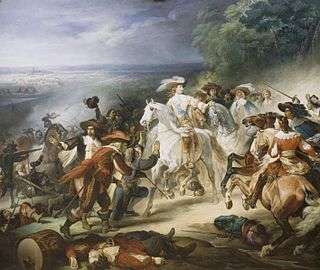
In 1643 Enghien was appointed to command against the Spanish in northern France. He was opposed by Francisco de Melo, and the tercios of the Spanish army were held to be the toughest soldiers in Europe. At the Battle of Rocroi (19 May) Enghien himself conceived and directed the decisive victory.[5]
After a campaign of uninterrupted success, Enghien returned to Paris in triumph, and tried to forget his enforced and hateful marriage with a series of affairs (after Richelieu's death in 1642 he would unsuccessfully seek annulment of his marriage in hopes of marrying Mlle du Vigean, until she joined the order of the Carmelites in 1647).[4] In 1644 he was sent with reinforcements into Germany to the assistance of Turenne, who was hard pressed, and took command of the whole army.[5]
The Battle of Freiburg (August) was desperately contested, but in the end the French army won a hard fought and inconclusive victory over the Bavarians and Imperialists, commanded by Franz Baron von Mercy. As after Rocroi, numerous fortresses opened their gates to the duke.
Enghien spent the next winter, as every winter during the war, amid the gaieties of Paris. The summer campaign of 1645 opened with the defeat of Turenne by Mercy at Mergentheim, but this was retrieved in the victory of Nördlingen, in which Mercy was killed, and Enghien himself received several serious wounds. The capture of Philippsburg was the most important of his other achievements during this campaign. In 1646 Enghien served under Gaston, Duke of Orléans in Flanders, and when, after the capture of Mardyck, Orléans returned to Paris, Enghien, left in command, captured Dunkirk (11 October).
Fronde
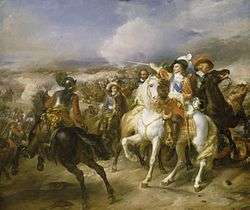
When he succeeded in 1646 as 'Prince of Condé,' his combination of military ability, status and enormous wealth meant he was viewed with considerable suspicion by Anne of Austria and Mazarin. His own lands included Burgundy and Berry, while the Prince de Conti, his brother, held Champagne and his brother-in-law, Longueville, controlled Normandy. In 1641, Louis XIII granted him Clermont-en-Argonne, ceded to France by the Duchy of Lorraine; in 1648, this was converted to an appanage, effectively making it independent of central authority.[6]
To remove him from Paris, Mazarin arranged for him to lead anti-Habsburg forces in the 1640-1659 Catalan revolt known as the Reapers' War. By 1648, this had become an increasingly bitter, multi-sided conflict between the Spanish, the Catalan nobility, supported by France, and the Catalan peasantry. As Mazarin had intended, Condé could achieve little; however, a Spanish revival in the Low Countries led to his recall and victory at Lens in August 1648.[5]
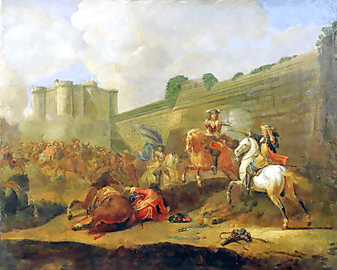
When the 1648-1653 Fronde broke out, Condé was recalled to Court by Anne of Austria to subdue the Parlement of Paris, which he quickly accomplished. The Parliamentary Fronde ended with the March 1649 Peace of Rueil but was followed by the far more serious Fronde des nobles, led by Condé. In January 1650, he was arrested, along with Conti and Longueville; imprisoned at Vincennes, when asked if he needed reading material, he allegedly replied 'The memoirs of M de Beaufort,' who made a dramatic escape from the same prison two years earlier.[7]
Turenne and his brother the Duke of Bouillon were among those who had escaped arrest; they now demanded the prisoners be released, leading to a short-lived alliance between the Fronde des nobles and the Fronde des parlements. While this resulted in their release in February 1651, the diverging interests of the two parties quickly led to a realignment of alliances, with Condé's party now faced by the Court, supported by the parliamentary Frondeurs. In addition, Turenne changed sides and his victory at the Battle of the Faubourg St Antoine in July 1652 ended the Fronde as a serious military threat.
Condé only escaped when the Duchess of Montpensier persuaded the Parisians to open the gates; in September, he and a few loyalists allied themselves with Spain. Despite victory over Turenne at Valenciennes in 1656,[2] defeat at the Battle of the Dunes in June 1658[8] led to the Treaty of the Pyrenees in 1659. This included a pardon for Condé and restoration to his previous titles but his power was largely broken and he did not hold another military command until 1667.[2]
Rehabilitation
.png)
Condé became a loyal supporter of Louis XIV, but did not hold military command again until 1667. He lived quietly at the Château de Chantilly, an estate inherited from his uncle, Henri II de Montmorency. Here he assembled a brilliant circle of literary men, including Molière, Racine, Boileau, La Fontaine, Nicole, Bourdaloue, and Bossuet.
About this time, negotiations between the Poles were carried on with a view to the royal elections in Poland, at first by Condé's son, Henri Jules de Bourbon, and afterwards by Condé himself. These, after a long series of curious intrigues, were finally closed later in 1674 by the veto of King Louis XIV and the election of John Sobieski. The Prince's retirement, which was only broken by the Polish question and by his personal intercession on behalf of Fouquet in 1664, ended in 1668.
During the 1666 to 1667 War of Devolution, Condé proposed to the Marquis de Louvois, the Minister of War, a plan for seizing Franche-Comté, the execution of which was entrusted to him and successfully carried out. He was now completely re-established in the favour of King Louis XIV, and with Turenne, was the principal French commander in the celebrated campaign of 1672 against the Dutch. At the forcing of the Rhine passage at Tolhuis (June 12), he received a severe wound, after which he commanded in Alsace against the Imperials.
In 1673, he was again engaged in the Low Countries, and in 1674, he fought his last great battle, the Battle of Seneffe, against William of Orange.[lower-alpha 1][9] This battle, fought on August 11, was one of the hardest of the century, and Condé, who displayed the reckless bravery of his youth, had three horses killed under him. His last campaign was that of 1675 on the Rhine, where the army had been deprived of its general by the death of Turenne; and where by his careful and methodical strategy, he repelled the invasion of the Imperial army of Raimondo Montecuccoli.
After this campaign, prematurely worn out by the toils and excesses of his life, and tortured by gout, Condé returned to Château de Chantilly, where he spent the eleven years that remained to him in quiet retirement. At the end of his life, Condé specially sought the companionship of Bourdaloue, Pierre Nicole, and Bossuet, and devoted himself to religious exercises. He died at the Palace of Fontainebleau on 11 November 1686, at the age of sixty-five. Bourdaloue attended him at his death-bed, and Bossuet pronounced his elegy.
Although marriage to Claire-Clémence de Maillé brought him a dowry of 600,000 livres and many lands, Condé's lifelong resentment of his forced marriage to a social inferior persisted.[10] In his last letter to Louis, he asked that his wife never be released from her exile to the countryside.
In 1685, his only surviving grandson, Louis de Bourbon, married Louise Françoise, eldest surviving daughter of Louis and his mistress Madame de Montespan. In mid-1686, Louise Françoise, later known as 'Madame la Duchesse', contracted smallpox while at Fontainebleau; Condé helped nurse her back to health, and prevented Louis from seeing her for his own safety. Although Louise Françoise survived, the Prince became ill, allegedly from worry over her health; on 11 November 1686, he died at Fontainebleau, and was buried at Vallery, traditional resting place for the Princes of Condé; his estranged wife survived until 1694.
Ancestry
| Ancestors of Louis, Grand Condé | ||||||||||||||||||||||||||||||||||||||||||||||||||||||||||||||||||||||||||||||||||||||||||||||||||||||||||||||||||||||||||||||||||||||||||||||||||||||||||||||||||||||||||||||||||||||||||||||||||||||||||||||||||||||||||||||||||||||||||||||||||||||||||||||||||||||||||||||||||||||||||||||||||||||||||||||||||||||||||||||||||||||||||||||||||||||||||||||||||||||||||||||||||||||||||||||||||||||||||||||||||||||||||||||||||||||||||||||||||||||||||||||||||||||||||||||||||||||||||||||||||||||||||||||||||||||||||||||||||||||||||||||||||||||||||||||||||||||||||||||||||||||||||||||||||||||||||||||||
|---|---|---|---|---|---|---|---|---|---|---|---|---|---|---|---|---|---|---|---|---|---|---|---|---|---|---|---|---|---|---|---|---|---|---|---|---|---|---|---|---|---|---|---|---|---|---|---|---|---|---|---|---|---|---|---|---|---|---|---|---|---|---|---|---|---|---|---|---|---|---|---|---|---|---|---|---|---|---|---|---|---|---|---|---|---|---|---|---|---|---|---|---|---|---|---|---|---|---|---|---|---|---|---|---|---|---|---|---|---|---|---|---|---|---|---|---|---|---|---|---|---|---|---|---|---|---|---|---|---|---|---|---|---|---|---|---|---|---|---|---|---|---|---|---|---|---|---|---|---|---|---|---|---|---|---|---|---|---|---|---|---|---|---|---|---|---|---|---|---|---|---|---|---|---|---|---|---|---|---|---|---|---|---|---|---|---|---|---|---|---|---|---|---|---|---|---|---|---|---|---|---|---|---|---|---|---|---|---|---|---|---|---|---|---|---|---|---|---|---|---|---|---|---|---|---|---|---|---|---|---|---|---|---|---|---|---|---|---|---|---|---|---|---|---|---|---|---|---|---|---|---|---|---|---|---|---|---|---|---|---|---|---|---|---|---|---|---|---|---|---|---|---|---|---|---|---|---|---|---|---|---|---|---|---|---|---|---|---|---|---|---|---|---|---|---|---|---|---|---|---|---|---|---|---|---|---|---|---|---|---|---|---|---|---|---|---|---|---|---|---|---|---|---|---|---|---|---|---|---|---|---|---|---|---|---|---|---|---|---|---|---|---|---|---|---|---|---|---|---|---|---|---|---|---|---|---|---|---|---|---|---|---|---|---|---|---|---|---|---|---|---|---|---|---|---|---|---|---|---|---|---|---|---|---|---|---|---|---|---|---|---|---|---|---|---|---|---|---|---|---|---|---|---|---|---|---|---|---|---|---|---|---|---|---|---|---|---|---|---|---|---|---|---|---|---|---|---|---|---|---|---|---|---|---|---|---|---|---|---|---|---|---|---|---|---|---|---|---|---|---|---|---|---|---|---|---|---|---|---|---|---|---|---|---|---|---|---|---|---|---|---|---|---|---|---|---|---|---|---|---|---|---|---|---|---|---|---|---|---|---|---|---|---|---|---|---|---|---|---|---|---|---|---|---|---|---|---|---|---|---|---|---|---|---|---|---|---|---|---|---|---|---|---|---|---|---|---|---|---|---|---|---|---|---|---|---|---|---|---|---|---|---|---|---|---|---|---|---|---|---|---|---|---|---|---|---|---|---|---|---|---|---|---|---|---|---|---|---|---|---|---|---|---|---|---|---|---|---|---|---|---|---|---|---|---|---|---|---|---|---|---|---|
| ||||||||||||||||||||||||||||||||||||||||||||||||||||||||||||||||||||||||||||||||||||||||||||||||||||||||||||||||||||||||||||||||||||||||||||||||||||||||||||||||||||||||||||||||||||||||||||||||||||||||||||||||||||||||||||||||||||||||||||||||||||||||||||||||||||||||||||||||||||||||||||||||||||||||||||||||||||||||||||||||||||||||||||||||||||||||||||||||||||||||||||||||||||||||||||||||||||||||||||||||||||||||||||||||||||||||||||||||||||||||||||||||||||||||||||||||||||||||||||||||||||||||||||||||||||||||||||||||||||||||||||||||||||||||||||||||||||||||||||||||||||||||||||||||||||||||||||||||
Issue
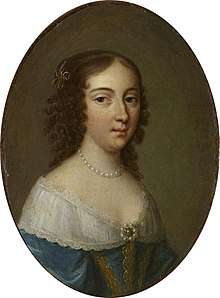
Louis married Claire-Clémence de Maillé-Brézé, daughter of Urbain de Maillé-Brézé, Marquis of Brézé and Nicole du Plessis de Richelieu, at the Palais Royal in Paris, in February 1641, in the presence of King Louis XIII of France, Anne of Austria, and Gaston d'Orléans. Their children were:
- Henri Jules de Bourbon, Duke of Enghien (29 July 1643, Paris – 1 April 1709, Paris), who later succeeded as Prince of Condé, married Princess Anne Henriette of the Palatinate and had issue.
- Louis de Bourbon, Duke of Bourbon (20 September 1652, Bordeaux – 11 April 1653, Bordeaux), died in infancy.
- X de Bourbon, Mademoiselle de Bourbon (1657, Breda – 28 September 1660, Paris), also died in infancy.
Titles and styles
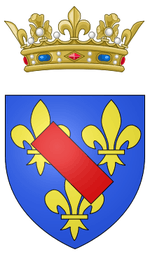
- 8 September 1621 – 26 December 1646 His Serene Highness the Duke of Enghien

- 26 December 1646 – 11 November 1686 His Serene Highness the Prince of Condé

Legacy
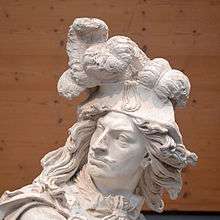
That he was capable of waging a methodical war of positions may be assumed from his campaigns against Turenne and Montecucculi, the greatest generals opposing him. But it was in his eagerness for battle, his quick decision in action, and the stern will which sent his regiments to face the heaviest losses, that Condé earned the right to be compared to the great generals of his time. Upon the Grand Condé’s death, Louis XIV pronounced that he had lost "the greatest man in my kingdom."
In 1643 his success at the Battle of Rocroi, in which he led the French army to an unexpected and decisive victory over the Spanish, established him as a great general and popular hero in France. Together with the Marshal de Turenne he led the French to a favorable peace in the Thirty Years' War.
During the Fronde, he was courted by both sides, initially supporting Mazarin; he later became a leader of the princely opposition. After the defeat of the Fronde he entered Spanish service and led their armies against France, notably at Arras, Valenciennes and Dunkirk. He returned to France only after the Treaty of the Pyrenees in 1659, but soon received military commands again.
Condé conquered the Franche-Comté during the War of Devolution and led the French armies in the Franco-Dutch War together with Turenne. His last campaign was in 1675, taking command after Turenne had been killed, repelling an invasion of an imperial army.
He is regarded as one of the premier generals in world history, whose masterpiece, the Battle of Rocroi, is still studied by students of military strategy.
His descendants include the present-day pretenders to the throne of France and Italy and the kings of Spain and Belgium.
He was portrayed in the film Vatel by Julian Glover.
Notes
- afterwards King William III of England
References
- Wolf 1968, p. 4.
- Tucker 2011, p. 838.
- Ouvrard, Jean-Marie. "Poussard". Les Blasons de la Charente (in French). Retrieved 2008-04-13.
- Spanheim, Ézéchiel (1973). Emile Bourgeois (ed.). Relation de la Cour de France. le Temps retrouvé (in French). Paris: Mercure de France. pp. 319.
- Keegan & Wheatcroft 1996, p. 61.
- Monter, William (2007). Calabi, Donatella (ed.). Cultural Exchange in Early Modern Europe (2013 ed.). CUP. p. 118. ISBN 978-1107412798.
- Swann, Julian (2017). Exile, Imprisonment, or Death: The Politics of Disgrace in Bourbon France, 1610-1789. OUP. p. 105. ISBN 978-0198788690.
- Livet 1970, p. 424.
- Wolf 1968, p. 241.
- Spanheim, Ézéchiel (1973). Emile Bourgeois (ed.). Relation de la Cour de France. le Temps retrouvé (in French). Paris: Mercure de France. pp. 93–94.
Sources
| Wikimedia Commons has media related to Louis, Grand Condé. |
- Keegan, John; Wheatcroft, Andrew, eds. (1996). Who's Who in Military History: From 1453 to the Present Day. Routledge.CS1 maint: ref=harv (link)
- Livet, G. (1970). "International Relations and the Role of France, 1648-1660". The New Cambridge Modern History:The Decline of Spain and the Thirty Years Wars, 1609-1659. IV. Cambridge at the University Press.CS1 maint: ref=harv (link)
- Tucker, Spencer C., ed. (2011). A Global Chronology of Conflict: From the Ancient World to the Modern Middle East. Vol. II. ABC-CLIO.CS1 maint: ref=harv (link)
- Wolf, John B. (1968). Louis XIV. W.W. Norton & Company, Inc.CS1 maint: ref=harv (link)

- Katia Béguin, Les Princes de Condé (Seyssel: Champ Vallon, 1999)
Louis, Grand Condé Cadet branch of the House of Bourbon Born: 8 September 1621 Died: 11 November 1686 | ||
| French nobility | ||
|---|---|---|
| Preceded by Henri de Bourbon |
Prince of Condé 26 December 1646 – 11 November 1686 |
Succeeded by Henri Jules de Bourbon |